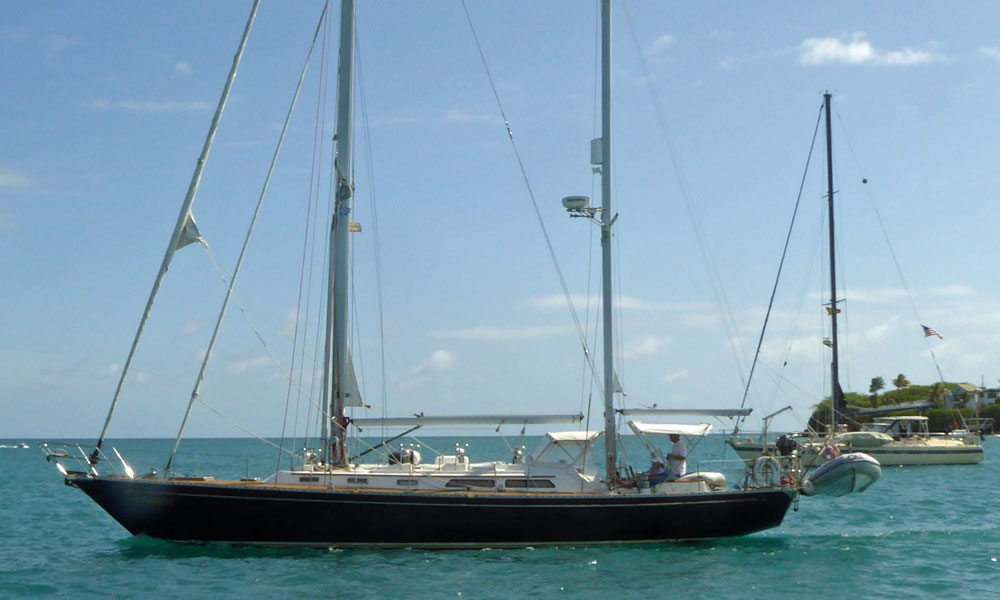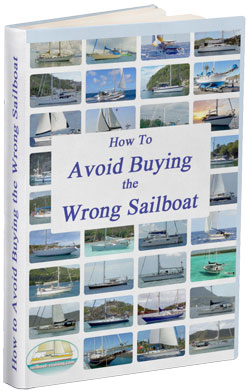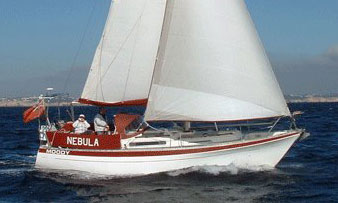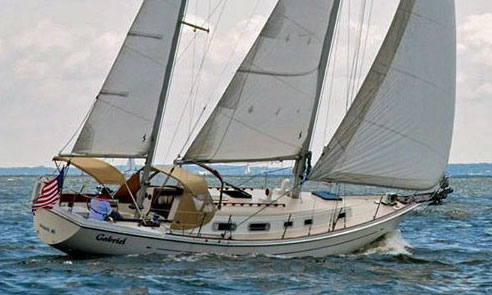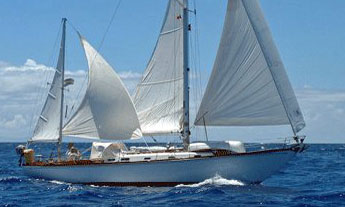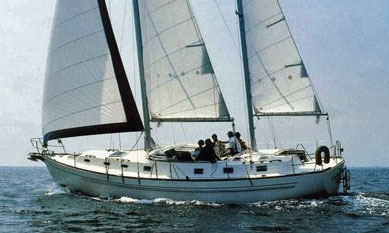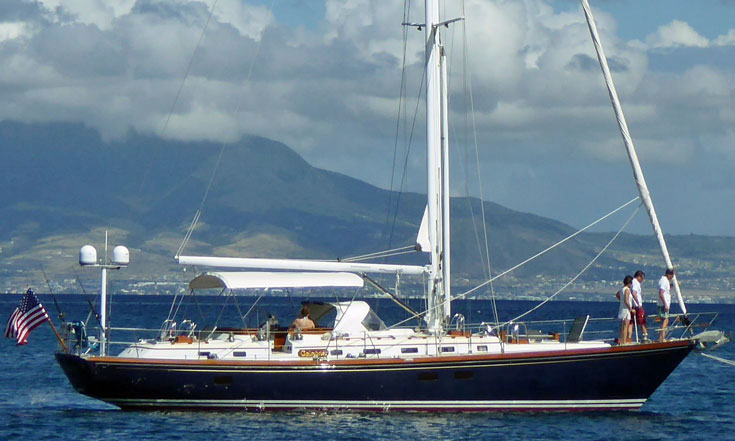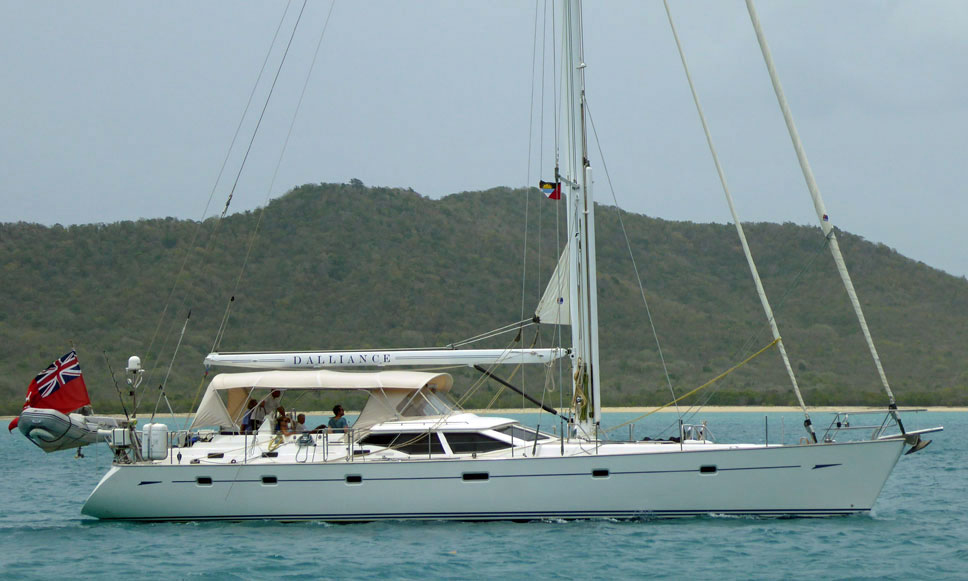- Home
- Sailboats 50'-55'
- Alden 54
The Alden 54 Sailboat
Specs & Key Performance Indicators
The Alden 54 sailboat was designed by Niels Christian Helleberg and manufactured by Alden Yachts in the USA throughout the years 1985 to 2002.
Published Specification for the Alden 54
Keel & Rudder Configuration: Centreboard keel & skeg-hung rudder
Hull Material: GRP (Fibreglass)
Length Overall*: 54'1" (16.5 metres)
Waterline Length*: 40'0" (12.2 metres)
Beam*: 14'4" (4.4 metres)
Draft*: 10'6" (3.2 metres) with the centreboard down; 5'6" (1.7 metres) with the centreboard up.
Rig Type: Staysail ketch (also produced with a cutter rig)
Displacement*: 36,500 pounds (16,556 kilograms)
Ballast*: 15,000 pounds (6,804 kilograms)
Sail Area*: 1,010 ft² (93.8 m²)
Water Tank Capacity: 1,000 litres (approximately 220 Imperial gallons).
Fuel Tank Capacity: 800 litres (approximately 176 Imperial gallons)
Hull Speed: 8.5 knots
Designer: Niels Christian Helleberg
Builder: Alden Yachts (USA)
Year First Built: 1985
Year Last Built: 2002
Number Built: Not known
* Used to derive the design ratios referred to later in this article - here's how they're calculated...
Design Options & Alternatives
Design Options
Rig Type: The Alden 54 was originally designed with a cutter rig, featuring a single mast with a jib and a staysail, in addition to the mainsail. However, buyers also had the option for a ketch rig, which included a second, smaller mizzen mast behind the main mast, with a mizzen sail and mizzen staysail.
Deep or Shallow Draft: The Alden 54 incorporated a centreboard keel. This design allows the draft to be varied significantly, from a deeper draft of 10'6" (3.2 metres) with the centreboard down, to a shallower draft of 5'6" (1.7 metres) when the centreboard is raised. This provides flexibility for navigating both deep and shallow waters.
Interior Layouts: There were two primary interior layout options for the Alden 54: a centre cockpit version and an aft cockpit version.
- The centre cockpit version featured a larger aft cabin with an en-suite head and shower, a smaller cockpit, and a larger deckhouse. The sleeping arrangement typically included a double berth in the aft cabin, two single berths in the V-berth cabin, and three additional berths in the saloon (one on each settee and one on the pilot berth).
- The aft cockpit version had a smaller aft cabin with a separate head and shower. It included a double berth in the aft cabin, two single berths in the V-berth cabin, and two more berths in the saloon (one on each settee). Both versions shared similar layouts in the forward part of the boat, including a V-berth cabin, a head with shower, a saloon with settees and a table, a U-shaped galley, and a navigation station.
Variations: The Alden 54 itself appears to be an evolution or variation of earlier Alden designs, specifically noted as being related to the "Alden 50/52" with an "Extended Stern, Ketch" rig as an alternative version. While the provided information doesn't explicitly detail "later versions" of the Alden 54 with different model numbers, it does highlight the flexibility in its design (e.g., centre vs. aft cockpit, cutter vs. ketch rig) that allowed for variations within its production run.
Some sources refer to it alongside the Alden 50 and 52, suggesting a similar design platform with variations in length and features. The Alden 52, for example, shares a "Keel/CB & spade rudder" hull type and has various layout options, including traditional or reverse transoms, and centre and aft cockpits, which aligns with the flexibility seen in the Alden 54.
Sail Areas & Rig Dimensions
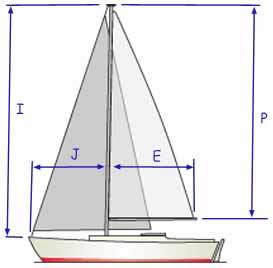 Sail Areas & Rig Dimensions
Sail Areas & Rig DimensionsSail Areas
- Mainsail Area: 453 ft² (42.1 m²).
- 100% Jib Area (Foretriangle): 557 ft² (51.7 m²).
- Total sail area (main plus 100% foretriangle): 1,010 ft² (93.8 m²).
Rig Dimensions
- I (Foretriangle Height): 60'2" (18.35 metres).
- J (Foretriangle Base): 18'5" (5.64 metres).
- P (Mainsail Hoist): 53'3" (16.25 metres).
- E (Mainsail Foot): 17'0" (5.18 metres).
Published Design Ratios
The Key Performance Indicators (KPIs)
- Sail Area/Displacement Ratio (SA/D): 17.8
- Ballast/Displacement Ratio: 41.1
- Displacement/Length Ratio (D/L): 255
- Comfort Ratio: 36
- Capsize Screening Formula: 1.7
Theoretical Sailing Characteristics
These design ratios offer insights into the Alden 54's theoretical sailing performance:
Sail Area/Displacement Ratio (SA/D): 17.8
This ratio indicates the amount of sail area a boat carries relative to its displacement. A value of 17.8 suggests the Alden 54 has a reasonable amount of sail area for its size and weight. Boats with higher SA/D ratios tend to accelerate faster and perform better in lighter winds. While not extremely high (racer/cruisers might be 20+), 17.8 points to a boat that should be capable of good performance in a variety of conditions, not feeling underpowered in light air, yet not excessively overpowered in stronger breezes. It suggests a balanced cruiser with good light-wind capabilities for its displacement.
Ballast/Displacement Ratio: 41.1%
This ratio indicates the percentage of the boat's total displacement that is comprised of ballast. A ratio of 41.1% is considered relatively high for a cruising sailboat. This high ballast ratio contributes significantly to the boat's stability and stiffness. It means the Alden 54 will likely stand up well to a press of sail, resisting excessive heeling and providing a comfortable and secure motion, especially in heavier seas. This characteristic is highly desirable for offshore cruising.
Displacement/Length Ratio (D/L): 255
The Displacement/Length ratio is a measure of a boat's relative weight for its waterline length. A D/L of 255 falls into the category of a moderate to heavy displacement cruiser.
- Moderate displacement (200-300): Boats in this range are generally considered good all-around performers. They have enough displacement to carry cruising gear comfortably and offer a stable ride, while still being able to achieve decent speeds.
- The Alden 54's D/L of 255 indicates it is designed for comfortable, capable cruising. It won't be a light, twitchy racer, but it also won't be a sluggish heavy displacement boat. It should be able to carry a substantial load of provisions and gear without a significant impact on performance, and its motion through the water should be comfortable and predictable, especially in a seaway.
Comfort Ratio: 36
The Comfort Ratio is an indicator of how comfortable a boat's motion will be in a seaway, with higher numbers generally indicating a more comfortable ride. A ratio of 36 is quite high, suggesting the Alden 54 will offer a very comfortable motion in rougher conditions. Boats with high comfort ratios tend to be less prone to hobby-horsing or snapping motions, providing a smoother ride for those on board. This aligns well with its design as a capable offshore cruiser.
Capsize Screening Formula: 1.7
The Capsize Screening Formula is a simple calculation used to give a general idea of a boat's susceptibility to capsize in very rough conditions. A lower number indicates greater resistance to capsize. A value of 1.7 is excellent and falls well within the range considered very safe for offshore sailing (generally, anything under 2.0 is considered very good, and under 2.5 is acceptable for ocean passages). This ratio, combined with the high ballast ratio, reinforces the Alden 54's reputation as a stable and seaworthy vessel, well-suited for extended cruising and offshore passages.
In summary, the design ratios for the Alden 54 suggest a highly capable and comfortable offshore cruising sailboat. It possesses a good balance of sail area to displacement for decent performance, a high ballast ratio for excellent stability, a moderate displacement for comfortable load-carrying and a smooth motion, and a very favourable capsize screening formula for enhanced safety in heavy weather. It's theoretically designed to be a comfortable, stable, and reliable boat for blue-water cruising.
But the Design Ratios Don't Tell the Whole Story...
While design ratios offer a valuable preliminary insight into a sailboat's theoretical characteristics, it's crucial to understand their limitations when defining actual sailing performance:
Simplification of Complex Hydrodynamics and Aerodynamics:
- Hull Shape and Distribution of Volume: Ratios like D/L only consider overall displacement and waterline length. They don't account for the specific shape of the hull, such as fine entries, full sections, or transom width. Two boats with the same D/L could have vastly different underwater profiles, leading to variations in wave-making resistance, wetted surface area, and ultimate speed potential. Similarly, the location of maximum beam and the shape of the ends significantly influence a boat's motion and performance upwind and downwind.
- Keel and Rudder Design: The Ballast/Displacement ratio doesn't account for the type or depth of the keel or the shape and area of the rudder. A deeper, higher aspect ratio fin keel will offer more lift and less drag than a full keel, even with the same ballast ratio, leading to better upwind performance. The shape and placement of the ballast (internal vs. external, lead vs. iron) also significantly impact stability and righting moment, which isn't captured by the ratio alone.
- Sail Plan Efficiency: The Sail Area/Displacement ratio uses a simplified calculation of sail area (main + 100% foretriangle), which doesn't account for the actual shape, aspect ratio, or efficiency of the sails. A modern, high-aspect ratio sail plan with efficient foils will perform better than an older, lower-aspect ratio rig, even with the same SA/D. The number of sails (sloop vs. ketch vs. cutter) also affects handling and efficiency in different wind conditions.
Lack of Dynamic Performance Information:
- Righting Moment Curve: The Ballast/Displacement ratio gives an indication of initial stability, but it doesn't describe the full righting moment curve. This curve shows how the boat's stability changes as it heels. A boat might have a high initial stability (stiffness) but lose it rapidly at higher angles of heel, or vice-versa. The Capsize Screening Formula provides a very basic indication of resistance to capsize but is not a substitute for a detailed stability analysis.
- Resistance and Speed through Water: Ratios don't predict how a boat will actually accelerate or how well it will sail to its theoretical hull speed in various conditions. Factors like wetted surface area, appendage drag (keel, rudder, propeller), and hull roughness play significant roles.
- Handling Characteristics: Ratios cannot predict how a boat will feel at the helm, its responsiveness to steering inputs, its ability to track in a seaway, or its tendency to hobby-horse or roll. These are influenced by factors like rudder size and balance, hull rocker, and overall weight distribution.
Environmental and Crew Factors:
- Wind and Sea Conditions: Ratios are static numbers and don't reflect how a boat will perform in different wind strengths, sea states, or points of sail. A boat that excels in light air might be overpowered in heavy air, or one that handles well upwind might be challenging downwind.
- Crew Skill and Experience: The actual sailing performance is heavily influenced by the skill of the crew in trimming sails, steering, and making tactical decisions.
- Loading: The ratios are typically based on a "light ship" or "designed displacement." In practice, a cruising boat carries a significant amount of stores, fuel, water, and personal gear, which increases displacement and can alter the boat's trim and performance.
Absence of Construction and Quality Information:
- Ratios say nothing about the build quality, structural integrity, or seakindliness of a vessel. A poorly built boat, regardless of its ratios, will not perform or last as well as a well-built one. Materials used, scantlings, and construction techniques are vital but absent from these simple calculations.
Design Intent vs. Actual Use:
- Ratios reflect the designer's mathematical intent for certain characteristics, but the actual performance can deviate based on how the boat is used, maintained, and equipped by its owner.
In conclusion, while design ratios serve as a useful starting point for comparing boats and understanding broad design philosophies (e.g., whether a boat is likely a racer, cruiser, or heavy displacement), they provide an oversimplified picture. For a comprehensive understanding of a sailboat's true sailing characteristics, one needs to consider detailed hull lines, stability curves, sail plans, appendage designs, and real-world performance data, ideally combined with personal experience or professional evaluations.
More Specs & Key Performance Indicators for Popular Cruising Boats
Recent Articles
-
Hans Christian 43: Classic Bluewater Cruiser & Liveaboard Sailboat
Dec 10, 25 04:37 AM
Explore the Hans Christian 43: a legendary heavy-displacement, long-keel sailboat. Read our in-depth review of its specs, design ratios, and suitability for offshore cruising and living aboard. -
Planning Your Sailboat Liveaboard Lifestyle: An Ocean Sailor's Guide
Dec 06, 25 05:18 AM
Seasoned sailors share their methodical risk analysis for planning a secure Sailboat Liveaboard Lifestyle, covering financial, property, and relationship risks. -
Marine Cabin Heaters: The Expert’s Guide to Comfort & Safety at Sea
Dec 05, 25 06:52 AM
Choose the best Marine Cabin Heaters for your vessel. Expert advice on diesel, paraffin, and hot water systems for year-round cruising comfort.
